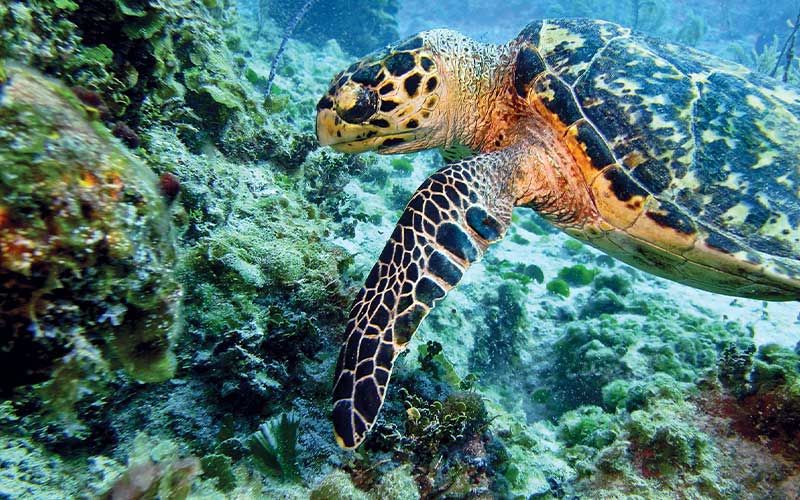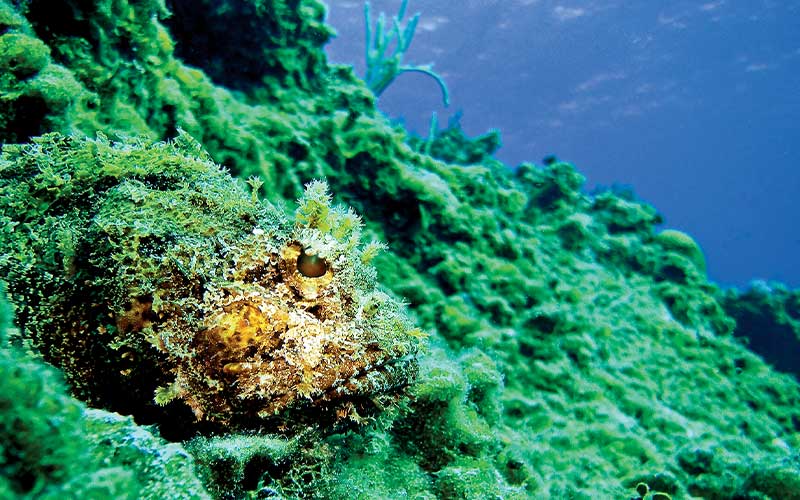If you don’t already know what eutrophication is, you soon will. If you’ve been diving recently in the Caribbean, the Coral Sea or many other places, chances are you have already beheld the effects of eutrophication with your own eyes.
When nutrients are added to a lake, river, estuary, lagoon or ocean, they invariably enhance the growth of some life forms (usually algae and sponges) at the expense of others; this is eutrophication. Eutrophication is the leading example of human activity degrading marine habitat in coastal waters, and it is always traceable to agricultural runoff, sewage (treated or otherwise) or both. Today the term is most frequently used to describe the effects on coral reefs from two groups of nutrients: phosphorus and nitrogen compounds.
Some problems reefs face, such as storm damage, are the result of natural causes. Others are the result of human activity; overfishing, sedimentation from runoff and acidification are prime examples. When these stress factors are present, even a modest increase in phosphorus and nitrogen can spell the end of a coral ecosystem. Eutrophication is usually the final step in a shift from complex reef communities — desirable for so many human endeavors and economies — to simple, much less diverse communities. Simply put, a predominantly coral community becomes a predominantly algae community.
Natural stressors such as coral bleaching and storms can be thought of as the forest fires of the reef. As bad as it looks right after the fire, the bleaching or the storm, the environment eventually benefits. Nature tends to periodically thin out areas choked with undergrowth, which stimulates resilience and new growth. Even coral reefs recover after a few years, possibly developing to even higher levels of complexity and community than before — provided the environment is fundamentally healthy.

Regime Shift
Suppose a storm-tossed reef happens to be in an area that has become high in phosphates and nitrates. Add additional stress in the form of declining algae-grazing fish due to overfishing, for example, and a coral-dominant regime may be replaced with a new regime. A regime shift is exactly what’s happening in places where agricultural runoff and sewage are raising the levels of nutrients that favor the growth of turf algae, macroalgae and even reef-destroying boring sponges. Algae and boring sponges are always present on a healthy reef, but corals and other kinds of sponges can compete and hold their own as long as the conditions favor their regime. But if nutrient levels increase and the coral community is weakened by stress, the invigorated algae and boring sponges will grow faster, cover newly exposed surfaces and smother living corals. When such a regime shift takes place, most creatures that depended upon the intricate and diverse elements found in the coral-and-sponge regime will leave or die to be replaced by life forms of the new, less diverse regime.
The elevated phosphates and nitrates that promote rapid growth of turf algae and macroalgae also encourage the expansion of encrusting and boring sponges, which break down the calcium carbonate structure of coral into fine powder. Some species of these destructive sponges have an utterly amazing capability for bioerosion. In fact, the scientific name for the Red Boring sponge is Cliona delitrix; the species name delitrix means “destroyer.” This encrusting sponge advances over hard, nonliving surfaces at a rate of 2 inches per year, but it moves twice this fast over living coral. It excavates and burrows deep tunnels into the very core of a coral colony as it grows. Studies show that this and similar bioeroding sponges are capable of removing solid material from the underlying coral at a rate roughly twice as fast as the coral can grow. Healthy coral can defend itself against invading larva of these sponges, but stressed reefs are unable to repel the destroyers.
Klaus Ruetzler, a research biologist at the Smithsonian Institution, confirms that in many coastal waters of the world sponges of the Cliona genus are destroying coral reefs at an unprecedented rate. The rate of reef destruction due to Cliona is directly related to eutrophication. After determining the percentage of reef covered by Cliona and other eutrophic organisms increases with proximity to sewage outfalls, some scientists have proposed using Cliona levels as a pollution index.
Is Recovery Possible?
There is hope, and it resides in the seeds of the coral regime that remain alive within the tangles of algae and in the water column above the reef. Since each regime possesses strong elements of the other, there is the inherent possibility we might still halt this cascading shift from the regime we want to the one we don’t. About half of coral reef scientists and administrators are convinced that with aggressive management and enforcement of existing and new environmental laws, the regime shift can be reversed. But the other half, noting obstacles such as the immense investment needed to reverse even portions of the eutrophication process, are skeptical about whether the political will exists to protect sensitive coral realms from the dangers of human waste and agriculture. Bonaire’s Ramon de Leon, manager of one of the oldest and most respected reef protection programs in the world, sums it up when he says, “I’m optimistic, and I wake up every day thinking there’s hope, but I also think realistically that the situation is not good at all.”
Biologists tell us sponges have played an important role in reef systems throughout time, especially in providing critical support to reef health during times of biological stress. Perhaps sponges are more resistant to eutrophication and other hazards like rising sea temperatures and ocean acidification than corals are. If so, we could once again see sponges become the dominant animals on Earth’s reefs instead of corals. It’s already happening.

Solutions
There are practices individuals can adopt to help reduce eutrophication: eating locally produced food, using biodegradable detergents without phosphates, reducing meat consumption and not dumping waste (even treated waste) into bodies of water. However, the problem exists primarily at the industrial and governmental levels. Governments of Baltic and some Caribbean nations, where eutrophication is most severe, are beginning to take steps to address it. Best-management practices for reducing phosphates and nitrates that enter the seas have been devised. As sources of agricultural phosphates grow scarcer, market forces are providing incentive to recover them before they enter coastal waters. As awareness of eutrophication grows, the hope is citizens will elect officials with the political will to implement phosphate and nitrogen remediation on a large scale.
© Alert Diver — Q2 Spring 2012